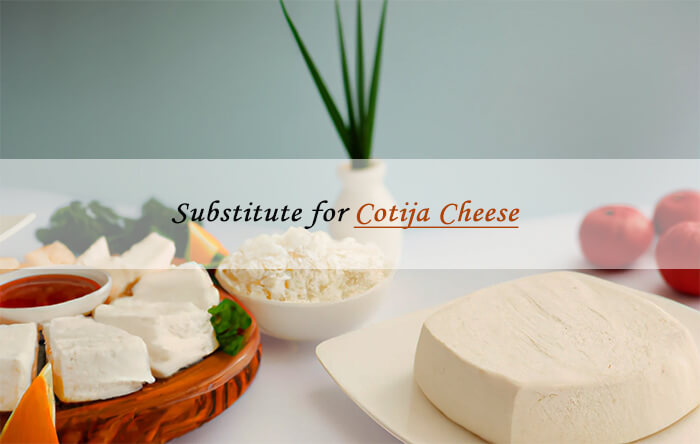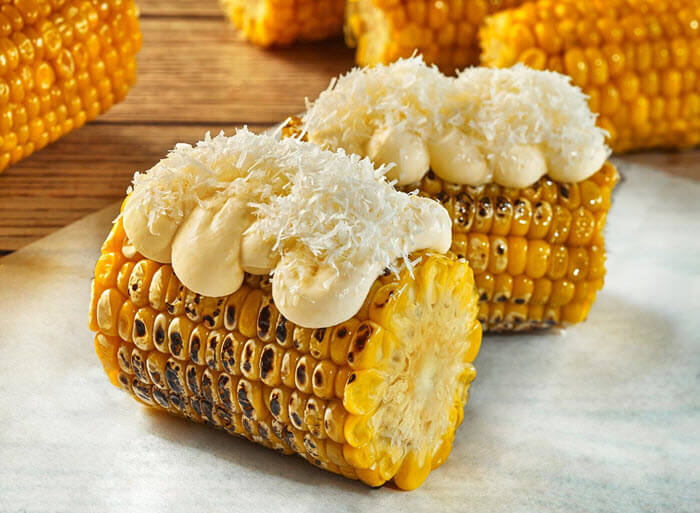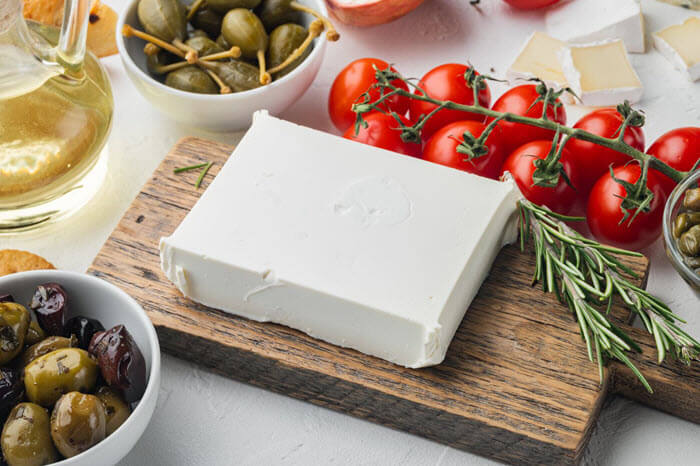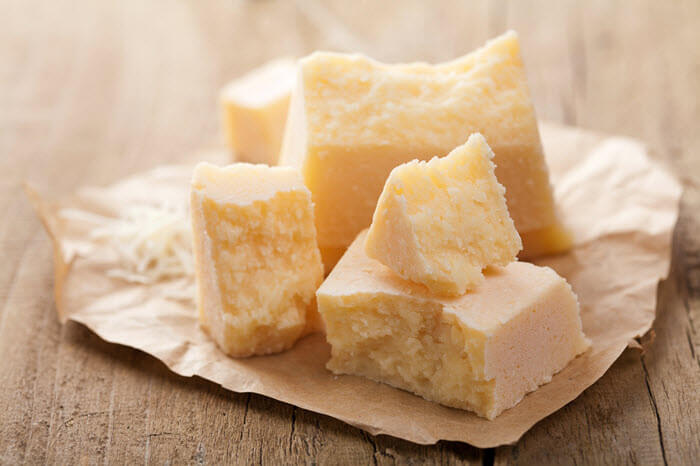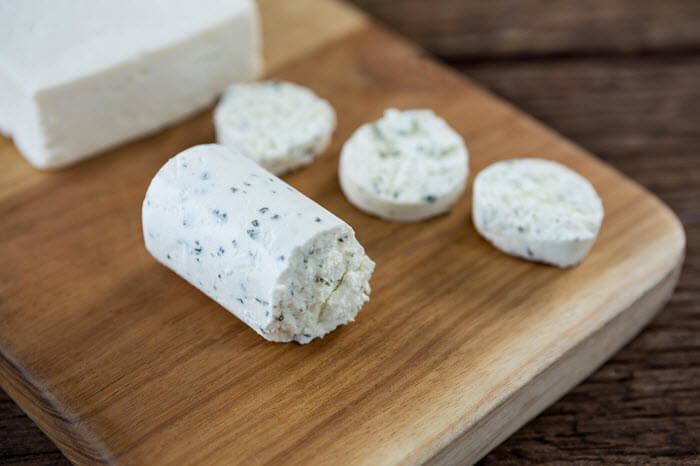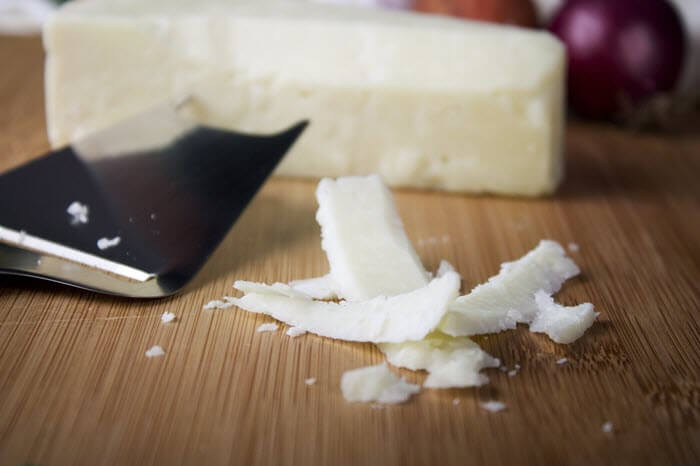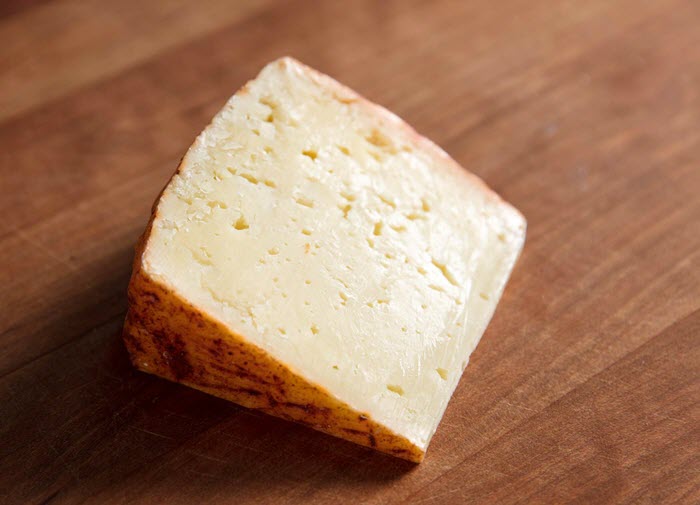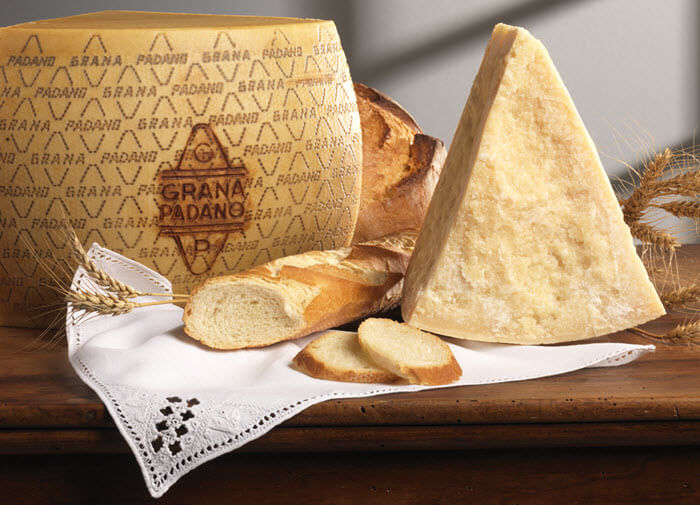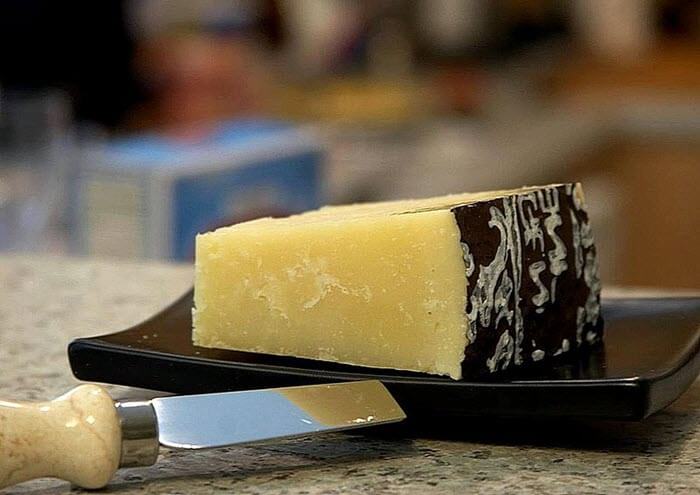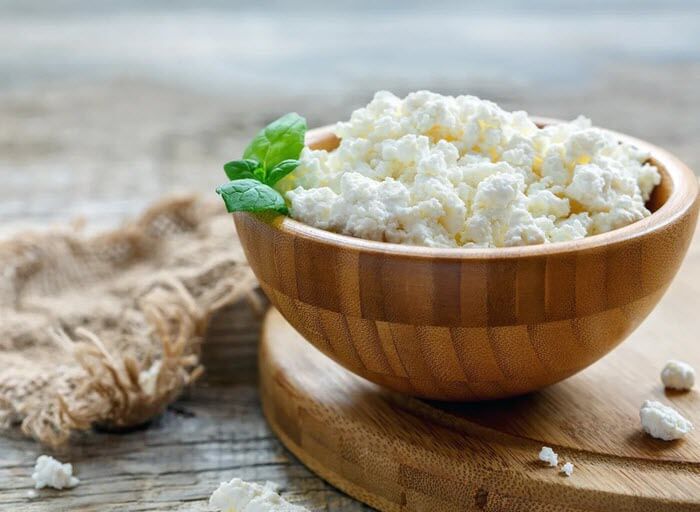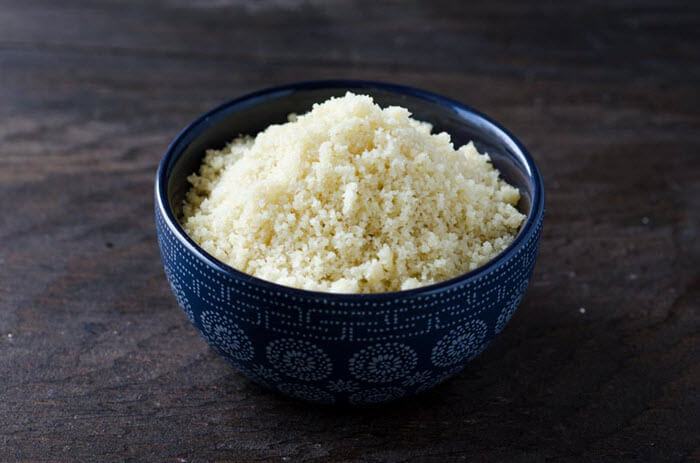Have you ever started a recipe thinking you have all of the ingredients just to find out that you’re missing something important? Haven’t we all!
Cotija cheese is a Mexican staple found in dishes ranging from salad, tacos, enchiladas, chillaquiles, migas, and so much more; but it can be awfully hard to find in your local chain grocery store.
Read on to find some cost-effective substitutes that can stretch your pennies and your recipes just a little bit farther.
Table Of Contents
Cotija Cheese 101
Street Corn, elotés, enchiladas, stuffed poblano peppers. Nothing makes these dishes better than cotija cheese, a salty cheese that crumbles to the touch and is most often used in Mexican cuisine.
Cotija is made from cow’s milk and has a salty flavor with a crumbly texture (think sweet parmesan with the crumble of dry feta). Named after the city in which it originated (Cotija) in Michoacan, Mexico.
Cotija cheese comes in two primary categories: fresh cotija (soft with a feta-like texture) and añejo, or aged cotija cheese, which has a more rigid texture similar to aged parmesan cheese. Cotija cheese has an added feature in that it melts very little when heat is applied to it keeping much of its original structure.
My personal favorite use of cotija cheese is on top of eloté fries paired with spicy mayo, cilantro, minced onion, and a pile of cilantro on top of a bed of crispy fresh curly fries. The cheesy crumble not only adds salt but much-needed texture to dishes that can be one note in texture.
What Can You Substitute for Cotija Cheese?
As a person with an affinity for lactose that my intestinal tract does not appreciate, I have spent many years searching for cotija cheese substitutes that are both dairy and dairy-free. While nothing quite compares to the sweet, yet salty bite of cotija cheese; these options come dangerously close!
Queso Fresco
By far the most similar option to fresh cotija cheese. Queso fresco has a similar crumble to a fresh cotija, with less of a salty bite and much more melt when heat is applied.
Directly translated, queso fresco means, “fresh cheese.” Containing a similar salty flavor with a creamier consistency than cotija typical of the crumble of semi-soft cheese.
Queso Fresco is an ideal substitute for Cotija when looking at dairy alternatives; however, queso fresco can be harder to find at your local chain grocery store. I usually locate queso fresco in stores that have a more curated selection of organic and fresh produce within the refrigerated dairy and egg section.
Although queso fresco can be harder to find, it is definitely a money saver compared to its more expensive cousin, cotija cheese. So if Cotija is out of your budget, stroll down to your local farmer’s market or specialty grocery store, and ask if they have queso fresco in stock for a fraction of the cost.
Feta Cheese
Another option that’s very close to cotija is crumbled feta cheese. Slightly more pungent in flavor with the addition of goat’s milk in addition to the cow’s milk base that it shares with Cotija, feta cheese is inexpensive in comparison to cotija cheese and much easier to find at a major chain grocery store than cotija or queso fresco may be.
Since feta is an aged cheese it has a tangy bite to it that is more similar to an aged cotija. It has a crumbly texture that can easily be broken down into the tiny crumbles associated with cotija cheese.
You may recognize this popular swap in some of the dishes you eat at Tex-Mex restaurants and taco bars. For example, Fuzzy’s is known for using a Mexican cheese blend as well as feta cheese crumbles on their tacos, salads, and other menu items. This adds a salty, fatty crumble that makes even the blandest salad feel decadent and flavorful hitting the important notes of salt, fat, and creaminess. Crumble feta finely to achieve the small crumble texture that is typical of a fresh of aged cotija.
Don’t know how to choose feta cheese? Here’s a guide for you: 7 Best Feta Cheese Review
Parmesan Cheese
Parmesan cheese is probably the most common of the substitutes that you may already have in your refrigerator or pantry. Though it is tangier in flavor than sweet cotija, crumbled finely, it can create the same salty crumble texture that an aged cotija can offer a dish.
If you have shredded or freshly grated parmesan, allow it to dry slightly and run it through the food processor until fine crumbles are achieved.
Parmesan is always my go-to for a quick and easy cotija cheese swap as it is usually aged for several years limiting the lactose in the cheese. As a highly lactose intolerant individual, parmesan cheese has a relatively low lactose content due to the aging process. In small amounts (crumbled on a salad or soup), parmesan has a minimal negative effect in my experience if you are a lactose-sensitive diner.
Goat Cheese
Goat cheese is the most pungent in flavor of the cheese substitutes mentioned thus far. Most similar to feta cheese as feta is also made up partially of goat milk, goat cheese has a higher content of goat’s milk and thus has more of a tang to it than the slightly milder feta cheese.
For the most similar consistency in texture in flavor, crumble the goat’s cheese into a small crumble (allowing it to air dry for 10-15 minutes may aid in this process if the goat cheese is a particularly moist batch). Once it is less moist, grating with a fine grater or zester can create signature cotija crumble, whereas a food processor may cause the softer goat cheese to consolidate into a creamy cohesive mixture rather than a crumble.
Goat cheese is great on a salad or on tacos and enchiladas to add an element of flavor and texture that may be missing from the dish.
Romano Cheese
Romano cheese is a happy medium between the sharp crumbly texture and flavor of parmesan, with sweet notes in the background and an aftertaste that is more similar to a cotija.
Romano cheese, when well grated, is an excellent substitute for cotija as it does have the sweet elements that parmesan may lack. Romano can also be used as a substitute for cotija in any method that cotija is traditionally used. A great addition to soups, salads, enchiladas, tacos, and my favorite – stuffed poblano.
To get the iconic crumble of a cotija from romano cheese, break it up in a food processor or with a fine grater to create a similar crumbly texture. As romano cheese is more typically found in Italian dishes, buying Romano as a substitute for cotija is another cost-effective method of getting around the higher prices of cotija as romano can be used in both Mexican and Italian cuisines as a substitute for its sharper sister, parmesan.
Añejo Cheese
Meaning, “old” or aged in English, añejo is a fantastic substitute for cotija cheese as it is also primarily made with a cow’s milk base and sometimes using goat’s milk.
However, añejo has a spicier flavor profile with its addition of a paprika coating around the outside giving it a reddish-colored rind. Due to the added smoky spiciness of the paprika, you may want to use a light hand on your other spices and adjust the final flavors to your personal taste to ensure the spicy añejo rind doesn’t overpower your dish and make it too spicy.
Añejo cheese has a similar level of saltiness and crumbles to cotija cheese and would make an excellent substitute if you don’t mind some additional spice.
Grana Padano
Grana Padano is crumbly and has a high salt content due to its long aging process.
It’s an Italian cheese made from cow’s milk that gives a similar taste profile to cotija, with a higher salt content caused by the long-age process used by Italian cheese-makers. Being that Grana Padano is nearly 10% salt, use sparingly or adjust your recipe’s salt content accordingly to avoid an overly salted dish. When using Grana Padano, I do my best to leave salting to the end after the cheese has been added to avoid having an overly salty dish.
Since it is an aged cheese, it will remain fresh and usable longer than soft cheeses and you will be able to use it longer.
It’s also a great substitute for parmesan in a basil or arugula pesto. Rind too dry or let the cheese dry out too much? It’s a great salt and flavor builder in soups and creamy sauce bases, just drop it in for at least 15 minutes and basque in the lovely salty flavor it adds to the composition of your soup or sauce.
Pecorino Romano
Similar in flavor profile and texture to Romano and parmesan cheese, pecorino romano also has a high salt content and a hard texture from the aging process that gives it a similar crumble to an aged cotija.
Similar to its flavor siblings, pecorino romano has a long aging process in which it is stored in cheese caves for at least 6-months in order to earn its salty flavor and crumbly texture that makes it such a good substitute for cotija cheese.
This cheese may be harder to find than its flavor sibling parmesan, but it can also be located at most farmer’s markets, cheeseries, and specialty grocery stores similar to queso fresco.
Being that it is an Italian cheese, it can be used in a multitude of cuisines including, but not limited to, Mexican, Italian, Mediterranean, Greek, and other cuisines around the Mediterranean that are based on tomatoes, bread, and cheese. This is a major money saver as it can also be used in soups and sauces to create a depth of flavor that cannot be matched by softer cheeses that have not undergone the aging process.
Cottage Cheese
All of my lactose-intolerant friends, listen up!
Cottage cheese is one of my personal favorite cheeses and when I discovered my lactose intolerance I was upset to lose access to this wonderfully salty and satisfying cheese that is loved by many dieters the world over. When I discovered that Lactaid has a lactose-free cottage cheese it changed my life! I had yet to find a soft cheese substitute that would feed my desire for creamy mac n’ cheese and alfredo pasta.
Blended with a little bit of garlic powder, chili powder, and lime and can create a beautifully creamy lime crema for any dish that will never make you miss lactose again. This is a great cotija substitute, but as it is so wet in composition, it works best when the cotija is mixed in and incorporated into a dish rather than sprinkled on top. To remove some of the liquid and retain the crumbly cheese curd texture, wring the liquid out of the cottage cheese with cheesecloth or a thin tea towel, and carefully separate the curds into individual pieces.
While not entirely a dupe for the crumble of a true cotija, the draining process can make it appear and feel closer to a cotija cheese in texture if you wish to use it on top of a dish and you are in a pinch.
Cotija Molido
Yes, you read that correctly, cotija molido is a form of cotija. However, it has a finer crumble to it as it is grated finely. This makes it a great addition to soups, pasta, pizzas, and salads.
Cotija molido is a great swap for cotija as it takes out some of the work of crumbling or grating a traditional cotija to get the crumbly texture it is so well known for.
There is little to no difference in flavor when compared to a traditional cotija cheese and is a great substitute with less work on the front end if you can find it. This can be used exactly like a traditional cotija cheese with a 1:1 ratio in any recipe.
Homemade Vegan Cotija Cheese with Hemp Seeds
Did you scroll all the way through this list and wonder where all of the dairy-free substitutes were? Well, you will not leave disappointed.
A super easy vegan cotija recipe that I use often uses a blend of shelled hemp seeds, nutritional yeast, and a brine liquid (I typically use the brine from capers that are a staple in my refrigerator, but olive brine or a dash of white wine vinegar would be an apt substitute).
I usually use a 3:1 ratio for the hemp seeds and nutritional yeast and about 1-3 teaspoons of the brine liquid to taste. Be careful not to add too much brine liquid as it can make the overall texture mushy. Mix thoroughly until the hemp seeds are evenly coated with the brine and the nutritional yeast.
The brine gives it the tang that you expect from a cotija cheese, the nutritional yeast gives that cheesy flavor, and the hulled hemp seeds provide the crumbly texture. As hemp seeds are the base, this is a great substitute for cotija as a topping as it will not melt when exposed to heat.
I’ve tried this mix in my eloté recipe and you’d never know it wasn’t the real thing!
Homemade Vegan Cotija Cheese with Almonds
Another great dairy-free option is a recipe that contains 1 cup of slivered almonds, 2 teaspoons of lemon juice, 2 teaspoons of brine (from a jar of olives), and salt to taste.
Here is how you can make it:
- Grind all of the ingredients in a food processor for about 4-5 minutes taking caution so as not to over blend as you may end up with tangy almond butter.
- Pulse instead of creating a steady blend to avoid overbending the mixture.
- Place the crumble mixture into a cheesecloth or a thin tea towel and squeeze any excess liquid from the mixture.
- Palace in the refrigerator for 24 hours for the flavors to meld together.
- Remove from the refrigerator and crumble the vegan cotija just as you would traditional cotija.
As this recipe has a 24-hour waiting period, one of the options above may better suit your cooking needs if you’re seeking a last-minute substitution for a dish.
Making your own cotija cheese from home can seem daunting at first, but in the long run you’ll save yourself a bundle of money making your own batch at home! Plus, it can be frozen to store for future use (up to 9 months) and used in nearly any dish that requires a touch of cheese.
If you consider yourself a kitchen adventurer that would like to add a new skill to your arsenal, attempting this homemade Cotija Cheese. I’ve provided some helpful links to products you’ll need for all your cheese making adventures on Amazon that you may not already have in your cooking arsenal. You’ll need…

Make Your Own Cotija Cheese
Make your own Cotija cheese at home!
Ingredients
- 1 gallon of milk
- 1 large cooking pot
- Electric mixer
- ½ cup salt for cheese making
- 1 Tablespoon Rennet
- 1 quart cheesecloth
- Cooking Thermometer
- Cheese Press
- 1 ½ cup salt (for brine)
- 1 quart warm water
Instructions
1. Heat milk in your large cooking pot to 100°F watching carefully to make sure milk does not burn or scald.
2. Add the cheese culture starter into the heated milk. Be careful to keep milk at a constant temperature of 100°F. You may need to adjust the cooktop temperature as you work to keep the milk consistently at 100°F.
3. After the milk has thickened, pour the milk mixture into your electric mixer. Add ½ cupof salt before mixing. Mix for roughly 20 minutes.
4. Dissolve 1 Tablespoon of Rennet in cool water. Pour Rennet mixture into the milk mixture and stir thoroughly.
5. Remove the pot from heat and allow it to cool to room temperature (about 60 minutes). Once the mixture has reached room temperature, the milk mixture should form small cheese curds. Cut curds into small cubes and use to cheese cloth the separate the cheese curds from the remaining whey liquid (the cloudy liquid surrounding the cheese curds).
6. Dry the cheese out using a cheese press for 30 minutes, then flip the cheese block and press for another 12 hours in the refrigerator to create the iconic crumbly texture of cotija cheese.
7. Dissolve the 1 ½ cups of salt in 1 quart of warm water, allow to return to room temperature. Soak the cotija cheese in the brine (it will still be soft) for 30 hours, flipping every 10 hours to create an even rind (the hardened layer on the outside of cheese).
8. Allow the cheese to ripen in your refrigerator for about 2 weeks. Place a glass container over the cheese, a cooling rack beneath the cheese, and a cloth or paper towel underneath the cooling rack to catch any residual crine or liquid that may drip from the cheese during the ripening process. If mold appears, simply wipe it away with a paper towel. Avoid wrapping the cheese during this process as it will impair the ripening process of the cheese.
9. Once the cheese has ripened, keep it in an airtight container in the refrigerator. Soft cheeses keep for up to 7 days in the fridge and harder cheeses can last up to 3-4 weeks.
FAQ’s (Frequently Asked Questions)
Can I use parmesan cheese instead of cotija cheese?
Yes, yes, yes! While parmesan is tangier in overall flavor, it can be used as a substitute for cotija when in a pinch or when attempting to stretch your wallet farther.
Can queso fresco replace cotija cheese?
Absolutely! Queso Fresco, while softer in texture and slightly sweeter in flavor than tangy cotija, is a fantastic substitute and more cost effective than its expensive cotija cousin.
Are cotija and queso the same?
Queso is the Spanish word for cheese. However, not all cheeses are created equal. Cotija is different because of where and how it is made, named after a city in Mexico.
Cotija is wildly different from a typical melted queso dip you’d find at a local restaurant (typically made from a mixture of soft cheeses, spices, and chiles) or in a jar at your local grocery store and should not be used as a substitute for cotija.
Read through the substitutions above to find a substitute that works for your budget and shopping needs.
Where to buy cotija cheese?
- Amazon – A personal favorite place of mine to shop for items that I cannot find in my local chain grocery stores. Since their partnership with Whole Foods, their selection of harder to find specialty cheeses and other items has massivel expanded. And – best of all – it can be delivered straight to your door!
- Walmart – I personally have had issues finding Cotija at my local Walmart Super Center, but check the store nearest you by perusing the dairy and deli sections or the online app to check availability at your local store. While Walmart’s selection can be limited in cheeses that are more niche, you can typically find one brand or (more easily) one of the substitutes from the list above.
- Target – Can’t find cotija at your local Walmart? Try Target! Target usually has more health conscious brands and a wider variety of options when it comes to specialty items. You will definitely be able to find several suitable substitution options from the list above and possibly even have multiple brands to choose from when selecting your perfect cotija cheese.
Feeling cheesy yet? I don’t know about you, but I’m dying to try my hand at making some homemade cotija cheese with my Lactaid milk! What personal spin will you put on your homemade cotija?

